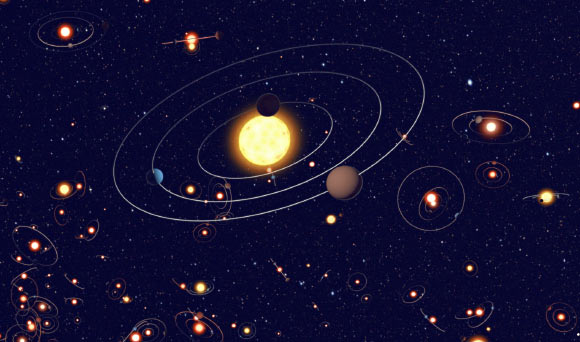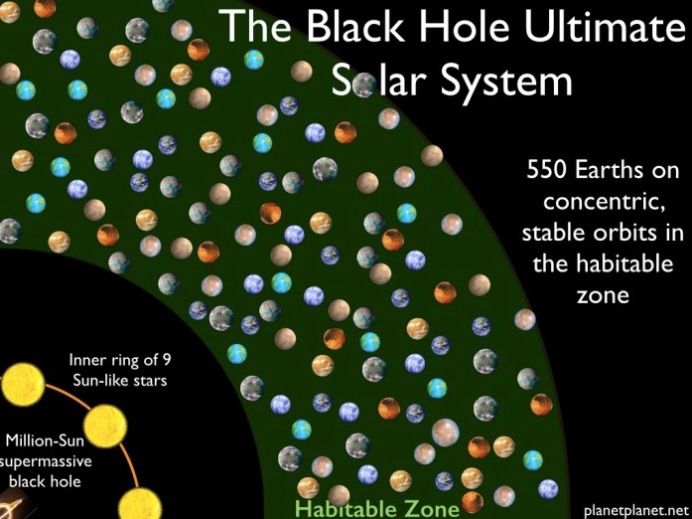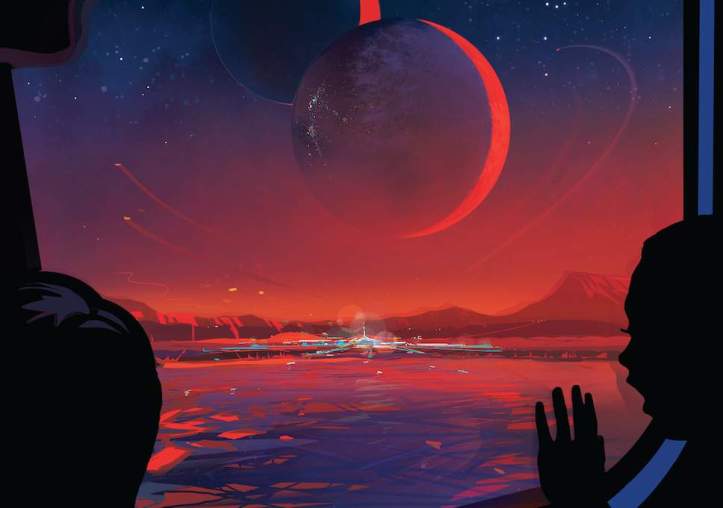Hello RTU readers. So today I’ll be writing about an idea that combines two of my favourite ideas in astrophysics; exoplanets and black holes. This post comes at an exciting time as I know now that from October I will be starting a PhD in Astrophysics at University College London, during which my research will involve theoretically modelling exoplanetary processes. Exoplanetary science has exploded over the last two decades, where we have gone from not conclusively knowing that other planets or planetary systems exist, to having over 3,786 confirmed planets in 2,834 systems, with 629 systems having more than one planet. It is has been one of those paradigm shifts where our perspective has managed to zoom out a level further, leaving us ever more humble with regards to our place and importance in this universe.

Photo Credit: NASA
From these numbers, our characterisation of other stars and some nifty extrapolations, assuming the universe is homogenous, (matter is evenly distributed and the same in all directions) we have calculated that in the universe there could be as many as 40 billion earth-like planets! By earth-like we usually mean that they exist in what is known as the habitable zone, a region which is sufficiently far away from its host star that it is not frazzled but close enough such that there is enough heat energy to sustain life i.e. conditions where water can exist. These numbers from exoplanetary research have opened our eyes towards our insignificance, having once thought of ourself as a special and rare ball floating at just the right distance from just the right size star, we now realise that this combination is far from unique. Of course, we should remember that these are the conditions for life we expect it, we refine our searches for life based on water. It is the only type of life we know and again we are blinded by our sample size and lack of comparison. Perhaps life has somehow evolved from different building blocks, all depends on your definition of life I suppose.. a tangent on which I shall not divert today.
I was sent an article by a true physics guru the other day pulling together exoplanets and black holes by Sean Raymond which sparked my interest. The premise is funky; theoretically what is the astrophysical system that could host the most life. (From now on I will speak of life we understand it, water based life on an earth-like planet.) When I say system, I mean similar to ‘solar system’, in our case we have our star, the sun, at the center with a host planets orbiting it at increasing distances. The restriction with having a singular star at the center of the system, is that planetary orbits can only come so close together before their gravitational effects start to pull on each other and dominate over the gravitational pull felt from the star. If this happens the orbits become unstable and the system falls out of its delicate balance. Key takeaway – there are only so many Earth-like planets you could fit into the habitable zone (set distance from the star) for a sun-like star before things get messy.

Credit: Sean Raymond
You need something heavier at the center of the system, such that more planets can be packed into the habitable zone whilst their gravitational effects on each other will still be overwhelmed by the gravitational mass in the center, meaning they stick to their orbits. In Raymond’s imaginary system, instead of a singular star at the center there is a super massive black hole. Taking a supermassive black hole 1 million times the mass of the sun, 550-Earth mass planets could fit in stable orbits in a set distance away from the center of the system. Of course replacing the sun with a black hole we loose the definition of habitability altogether, we need a sun-like star for heat and warmth. The funky idea theorised by Raymond to create a habitable zone is place to first place a ring of sun-like stars around the black hole. In fact, 9 sun-like stars 0.5 astronomical units from a one-milton mass sun would make 550 Earth-like planets habitable, with each planet circling in its own orbit. If taken a step further and orbits are shared with the planets spread out evenly throughout the ring, Raymond calculated the super-massive black hole could hold as many as 400 rings, each holding 2,500 planets. The beauty of this set up would be the sky show inhabitants of the worlds would enjoy, with other planets passing through large areas of the sky, day and night. In fact Raymond even goes so far as to suggest that planets would be close enough such that a space elevator could be constructed to connect them!

Photo Credit: NASA
Here’s one of my favourite aspects and of course it’s to do with time. Take a planet in one orbital ring and another in the orbit ring one further away from the black hole. The planet closer to the black hole will feel a significantly larger gravitational pull, hence being in a greater gravitational potential well, time will pass slower for them than planets in further orbits. See my previous posts on relativity and time dilation for some more insight in this disturbing phenomenon. As such, if two babies are born at what can be taken as the same moment in an external reference frame on two planets, the one on the inner ring would age slightly more slowly than the other. If taking the inner most and outer most habitable ring and two babies, the effect could be taken to bizarre extremes. The inner most baby could have reached it’s 2nd birthday while the outermost was seeing its grandchild reach their 2nd. Such discrepancy in one shared system, the effects of relativity plainly observable.
Of course this whole system is all theoretical fun and games and could be criticised for its fantasy, but it brings together ideas in theoretical and astrophysics nicely and i’m all for that at the moment. The system could be criticised by being ‘unnatural’ but if by that we mean statistically unlikely then we run into some trouble. Playing statistical games from our vantage point of the universe is a dangerous business. We only have one data point of life-formation, of data point of a life-bearing planet and a very small sample of universe which we can observe from our little corner of space. Although observations in exoplanetary science are continually stacking up, it is only from the spectra of light that we can do our de-coding, we have much still to learn about other systems. [See ‘Strange New Worlds‘ for some detail on these observations] If ‘unnatural’ is not meant from a statistically unlikely point of view alone then, what even is an unnatural system except something we as humans find inherently displeasing somehow? It is funny what the human mind can easily normalise, which when actually sat down and deeply thought about is mind-bending. I like this quote a lot to remind us of that;
“The fact that we live at the bottom of a deep gravity well, on the
surface of a gas covered planet going around a nuclear fireball 90
million miles away and think this to be normal is obviously some
indication of how skewed our perspective tends to be.”
— Douglas Adams, The Salmon of Doubt: Hitchhiking the Galaxy One
Last Time

I really wonder what’s out there.
How many lives are living in worlds so bizarre and better than ours perhaps.
What would it take for us to be part of their world ?
LikeLiked by 1 person
Step 1: A lot more funding into space exploration!
LikeLiked by 1 person
😄😄😄😄😄😄😄
That was cool!!!
LikeLike
I would love to see something like this in a science fiction novel.
LikeLiked by 2 people
An amazing concept but it centres around our obsession with finding life , and more importantly intelligent life. I often wonder if we have some inner emotional need to find company as we certainly are gregarious creatures and don’t fair well on desert islands. Alternatively it could be our restless natures always seeking and probing , but of course this is the nature of science , the pursuit of the unknown.
Most scientists and other thinkers start with the premise it must be out there somewhere and statistics confirm this by shear weight of numbers , and yet there remains an uneasy silence in answer from the stars.
LikeLike
Reblogged this on Planet Pailly and commented:
I’m still off on my blogging break, but I saw this really awesome post yesterday and wanted to share. You can call it science or you can call it science fiction. Either way, it’s a really cool concept to think about, so please enjoy.
LikeLiked by 1 person
It must be an exciting time to do astrophysics.
LikeLiked by 1 person
Methi you have exact posted that thing which I also interested in.The mysteries of universe specially black holes and galaxies amazed me.
Good job keep it up
LikeLiked by 1 person
It might be questionable as to whether or not thought makes us who we are: all neuronal actions are due to
Freud and Breuer’s urging and checking forces for the human psyche; we know what urging and checking mean,
so the question is how we define the human psyche from the activity of neurons!
How can we parse the distinction, there is no separation between quantum spin configuration and thought nor
can we bridge this idea of quantum polarity with human conscious thought. I find this to be the most incredible
aspect of human cognition!
There is a claim from theoretical physics that the universe was begun with an intensity of heat which is indescribable
by mathematics. On a universal scale of hot and cold seems to me the most fundamental aspect of reality; in other
words, how can hot and cold be the underlying meaning for everything? Is heat the cause for the existence of our
universe, which there are no known boundaries?
See Differential Form. See Tetryonic Theory
LikeLike